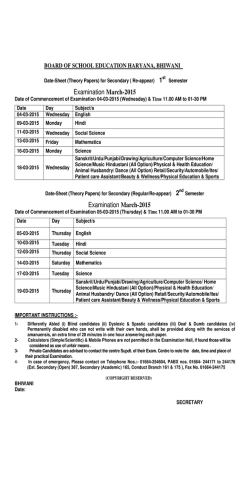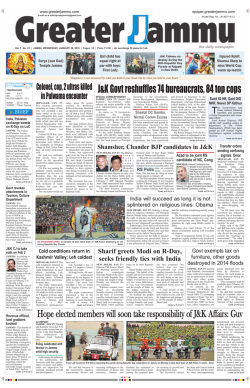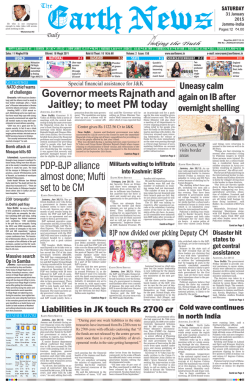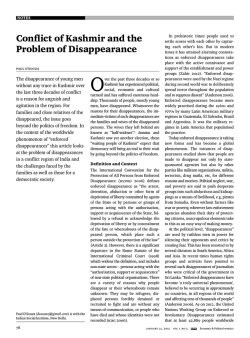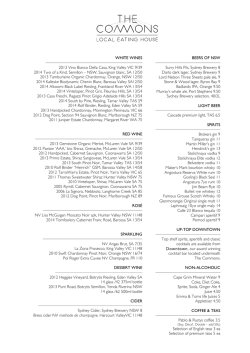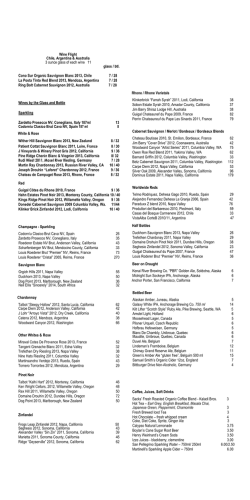
Download PDF
Vol 5 Issue 1 Feb 2015 ISSN No : 2230-7850 ORIGINAL ARTICLE International Multidisciplinary Research Journal Indian Streams Research Journal Executive Editor Ashok Yakkaldevi Editor-in-Chief H.N.Jagtap Welcome to ISRJ RNI MAHMUL/2011/38595 ISSN No.2230-7850 Indian Streams Research Journal is a multidisciplinary research journal, published monthly in English, Hindi & Marathi Language. All research papers submitted to the journal will be double - blind peer reviewed referred by members of the editorial board.Readers will include investigator in universities, research institutes government and industry with research interest in the general subjects. International Advisory Board Flávio de São Pedro Filho Federal University of Rondonia, Brazil Mohammad Hailat Dept. of Mathematical Sciences, University of South Carolina Aiken Hasan Baktir English Language and Literature Department, Kayseri Kamani Perera Regional Center For Strategic Studies, Sri Lanka Abdullah Sabbagh Engineering Studies, Sydney Ghayoor Abbas Chotana Dept of Chemistry, Lahore University of Management Sciences[PK] Janaki Sinnasamy Librarian, University of Malaya Ecaterina Patrascu Spiru Haret University, Bucharest Romona Mihaila Spiru Haret University, Romania Loredana Bosca Spiru Haret University, Romania Delia Serbescu Spiru Haret University, Bucharest, Romania Fabricio Moraes de Almeida Federal University of Rondonia, Brazil Anurag Misra DBS College, Kanpur Anna Maria Constantinovici AL. I. Cuza University, Romania Ilie Pintea, Spiru Haret University, Romania Xiaohua Yang PhD, USA George - Calin SERITAN Faculty of Philosophy and Socio-Political Sciences Al. I. Cuza University, Iasi ......More Titus PopPhD, Partium Christian University, Oradea,Romania Editorial Board Iresh Swami Pratap Vyamktrao Naikwade ASP College Devrukh,Ratnagiri,MS India Ex - VC. Solapur University, Solapur R. R. Patil Head Geology Department Solapur University,Solapur Rama Bhosale Prin. and Jt. Director Higher Education, Panvel Salve R. N. Department of Sociology, Shivaji University,Kolhapur Govind P. Shinde Bharati Vidyapeeth School of Distance Education Center, Navi Mumbai Chakane Sanjay Dnyaneshwar Arts, Science & Commerce College, Indapur, Pune Awadhesh Kumar Shirotriya Secretary,Play India Play,Meerut(U.P.) N.S. Dhaygude Ex. Prin. Dayanand College, Solapur Narendra Kadu Jt. Director Higher Education, Pune K. M. Bhandarkar Praful Patel College of Education, Gondia Sonal Singh Vikram University, Ujjain Rajendra Shendge Director, B.C.U.D. Solapur University, Solapur R. R. Yalikar Director Managment Institute, Solapur Umesh Rajderkar Head Humanities & Social Science YCMOU,Nashik S. R. Pandya Head Education Dept. Mumbai University, Mumbai Alka Darshan Shrivastava G. P. Patankar S. D. M. Degree College, Honavar, Karnataka Shaskiya Snatkottar Mahavidyalaya, Dhar Maj. S. Bakhtiar Choudhary Director,Hyderabad AP India. Rahul Shriram Sudke Devi Ahilya Vishwavidyalaya, Indore S.Parvathi Devi Ph.D.-University of Allahabad S.KANNAN Annamalai University,TN Sonal Singh, Vikram University, Ujjain Satish Kumar Kalhotra Maulana Azad National Urdu University Address:-Ashok Yakkaldevi 258/34, Raviwar Peth, Solapur - 413 005 Maharashtra, India Cell : 9595 359 435, Ph No: 02172372010 Email: [email protected] Website: www.isrj.org Indian Streams Research Journal ISSN 2230-7850 Impact Factor : 3.1560(UIF) Volume-5 | Issue-1 | Feb-2015 Available online at www.isrj.org AN ANALYSIS OF VIEWER PREFERENCE FOR INDIAN URDU-LANGUAGE TELEVISION CHANNELS AMONG THE INHABITANTS OF KASHMIR VALLEY: A STUDY Zahoor Hussain Bhat Sub-editor (Trainee) at United News of India (A National News Agency of India) Abstract:-Being associated with language from birth means an affiliation with the culture of the place represented by that language. If people will be familiar with an additional or second language compacted with identical cultural & linguistic elements, then both languages share a common undisturbed attribute. Similarly the case is with Urdu and Kashmiri language which is looking a mixed language product. Keeping in mind the influence of Urdu media in Kashmir valley the study attempts to analyze the viewer preference for Indian Urdu-language electronic Television Channels among the inhabitants of Kashmir Valley (one of the three regions of Jammu and Kashmir State) where Urdu is an official language. Keywords: Kashmir Valley, Urdu Television Channels, Programme Preference, Viewership, Popularity . INTRODUCTION: Man is by nature a social animal who can't live alone. He is bound to remain connected with other human beings in order to accomplish his social needs and requirements. He always want to remain informed of the happening taking place around him and feels the need to express his ideas, experiences, observations and share his knowledge with other human beings. In order to remain informed and express himself he puts to use different resources available. Even though in the olden times there where different but limited resources available for these purposes, however, the emergence of Mass Media brought revolution in this regard. Unending progress in Mass media is attributed to the growing needs and requirements of human beings. In fact as the world progresses, the needs and requirements of human being got further extended and in order to meet these needs and requirements, Mass Media revolution took place. Invention of Television and Radio is the result of the needs and requirements of human beings. Their popularity and later the emergence of social media could be called mass media revolution. In the beginning human beings were reliant on Radio for quenching information thirst. Later when the Television was invented, more and more people showed up their interest to know what is happening in the world. After achieving success in informing people as far as the information needs of the people were concerned, Radio and Television broadened its confines and start entertaining people by airing diversity of entertainment programs. It is established fact that TV and Radio programs do affect behaviours of viewers and listeners. However, if we talk of power, TV has a more power of influencing behaviours than Radio’s owing to its feature of visualization. Initially TV broadcast in India was limited to two hours in a week that too was available in some particular clubs of Delhi. Later this facility was introduced in some schools of Delhi to help children in educational matters. In 1965 Doordarshan started airing of daily one hour programmes. Thereafter launch of satellites projects like ‘Satellite Instructional Television Experiment in 1975’, ‘INSAT 1A in 1982’, ‘INSAT 1B in 1983’ and introduction of colour TV in India with the coverage of Delhi Asian Games held in 1982 revolutionized TV industry in India. In 1991 the then Prime Minister of India P.V. Narasimha Rao kick-started economic reforms to opens doors for foreign investors to avoid looming economic crisis. Under these reforms foreign private broadcasters were allowed to start Zahoor Hussain Bhat ,“AN ANALYSIS OF VIEWER PREFERENCE FOR INDIAN URDU-LANGUAGE TELEVISION CHANNELS AMONG THE INHABITANTS OF KASHMIR VALLEY: A STUDY” Indian Streams Research Journal | Volume 5 | Issue 1 | Feb 2015 | Online & Print 1 . An Analysis Of Viewer Preference For Indian Urdu-language Television Channels Among The Inhabitants Of Kashmir Valley: A Study limited services in India. Consequently foreign TV Channels like CNN and Start TV and Indian private TV Channels like Zee TV, ETV and Sun TV started satellite broadcasts in India. There are hundreds of TV Channels showing content of different genres like news, entertainment, infotainment, music, life style, movies, kid’s programmes, religious programmes, etc available to viewers today. They are results of the positive decision taken in 1991. A very good number of viewers watch TV to stay up to date of the happenings taking place in their areas, regions, states, countries or in the world over. Although News channels are meant to solely inform viewers of the happenings, whereas, infotainment channels inform and entertain viewers. News Channels telecast diversity of news based programmes besides news to retain interest of viewers, on the other hand infotainment channels telecast news, soaps operas and others interactive programs to keep viewers viewing their channels. A good number of TV channels are available today for the viewers of different regions and speakers of particular languages other than English and Hindi. Tamil Sun TV (1992) is considered as the first private channels of India. After its launch Malayalam Asianet (1993), Tamil Raj Television Network (1994) and ETV Network (1995) and other network started broadcasts in regional languages. Although the viewers of south Indian regional TV Channels are limited to the states, however, if we talk of Urdu News and infotainment TV channels of the country (India), the viewers of these channels are spread through the country and also in neighbouring countries. Every viewer of the TV wants to watch the TV programmes in the languages he/she knows so is the case with Urdu speakers. Urdu is an official language of the Jammu and Kashmir state. People (TV viewers) of the Kashmir Valley prefer to watch television in Urdu language and read Urdu newspapers. People of the Valley have been showing a great interest in knowing the events taking place throughout the globe mainly in the Kashmir Valley. Although Radio Kashmir Srinagar (the government-controlled non-commercial radio station operating in Kashmir) has been there since 1948. Doordarshan service has been available for the last several decades, particularly the fully dedicated DD Kashir since 2003. However, due to the political alienation people of Kashmir have always been relying on alternatives rather than remaining devoted to Radio Kashmir Srinagar, Doordarshan or full dedicated DD Kashir for information needs (for listening and watching news). Now the question is what in fact the alternative means that people had considered as credible and authentic ones were available here especially during eighties and nineties when information thirst was extremely felt in Kashmir. The uncontested and astonishing answer is – BBC’s Urdu Service and Voice of America’s Urdu Service (Radio Stations). There would hardly be any Radio listener in eighties and nineties who would miss to listen to current affairs programme Saerbeen on BBC Urdu. Muhammad Tasim Zahid in his article published in Jammu and Kashmir based English daily ‘Greater Kashmir’ has quoted Nasir Khan, a warm listen of BBC Urdu Service in nineties as having said “there was a time when all of us in the family would sit around a radio set at 8:30 PM to listen to Saerbeen”. The writes states that the programme (Saerbeen) was popular for objective and fearless reporting by its then correspondent Yusuf Jameel from Kashmir. He further writes “an opinion poll in New-Delhi based ‘Outlook’ magazine in mid-nineties found that a majority of the people considered BBC to be the most authentic source of news. With the arrival of news channels and improvement in the coverage of news in local print and electronic media (in Kashmir), Saerbeen’s audience declined”. In the first decade of twenty-first century many local cable TV Channels started airing local news, consequently, local audience started showing enough faith in the content that was being aired. However, this connection (between local cable TV Channels and its Kashmiri audience) did not last long. In 2008, a controversy erupted over transfer of state land to Amarnath Shrine Board Land; as a result, government banned all local cable channels in the state to thwart any alleged attempt of dissemination any mis-information and disinformation. Although the ban was lifted after almost one month but government again imposed ban on local cable TV Channels in 2010 when Kashmir erupted again. Government had defended its decision of banning local channels saying that according to Cable Network Act 1995 they (local cable TV channels) can’t telecast news. It is said that government has no proposal for lifting ban on local cable TV channels in near future. After blanket ban on telecast of news on local cable TV channels, Kashmiri audience were again left with no option but to lookout for alternative means. This time (in second decade of twenty-first century), unlike BBC Urdu Service or Voice of America Urdu Service, Kashmiri people reposed their trust on national private Urdu Television Channels especially on ETV Urdu which successfully ended up to be audience forte in Kashmir. Deploying reporters in every district, telecasting fully dedicated Kashmir bulletin and other current affairs programmes on Kashmir made it audience first choice. Besides ETV Urdu other Urdu TV Channels like Aalami Samay and Munsif TV too tried to strengthen its basis in the Valley by the means of telecasting fully dedicated news programmes. After all, the main aim of this study is to analyze viewer preference of the viewers of the Kashmir Valley for Indian Urdu-language Television Channels through a study. Indian Streams Research Journal | Volume 5 | Issue 1 | Feb 2015 2 . An Analysis Of Viewer Preference For Indian Urdu-language Television Channels Among The Inhabitants Of Kashmir Valley: A Study ABOUT INDIAN URDU TELEVISION CHANNELS ETV URDU: ETV Urdu – The 24-hour free-to-air digital channel was launched on 15 August, 2001 on the occasion of the Independence Day of the India by the chief editor Eenadu group of publications and chairman of the Ramoji Film City (RFC), CH Ramoji Rao. The network’s headquarters is in Ramoji Film City, Hyderabad. This channel was launched by Eenadu Television Network under its expansion plan and is presently owned by Network 18. The target audience of the channel are Urdu-speaking audiences in India and Gulf countries. It has a good viewership in India and it claims of having foot prints in more than 50 countries. The Channel telecasts mix of entertainment and information, hence an infotainment channel. ETV telecasts half-an-hour daily ETV Kashmir bulletin at 1900 hours since 2005. The bulletin focuses on political, social and cultural activities in the Jammu and Kashmir. It is believed that in the absence of any satellite TV specific to Jammu and Kashmir, the ETV Urdu’s half-an-hour news bulletin fills the gap and ETV management claims that it has become very popular in the region. ETV Urdu has been telecasting 30-minute Kashmir morning bulletin since May 20, 2012 as well. The decision to telecast morning bulletin according to the channel management was taken owing to massive response from the viewers to 30-minute evening bulletin. ETV Urdu launched a weekly half hour programme fully dedicated to Jammu and Kashmir, titled “Kashmir Express” which is telecast on every Monday. The programme was launched on 17th June 2013. On 31st August, 2014 the channel revived the ‘Laddi Shah’, an age old art of storytelling in Kashmir. It is being telecast on every Sunday at the end of the ‘ETV Urdu Kashmir’ news bulletin. DD URDU: DD Urdu came into existence on 15 August 2006 following a Governmental commitment in the Indian Parliament made in response to the un-starred question No. 2026 regarding launch of Urdu Channel. The channel has been on air for 24 hours from 14th November 2007 and claims to be available for Urdu knowing audience in India and parts of Asia, China and Gulf Countries. It is owned by Prasar Bharati and is headquartered at New Delhi. This channel has a mandate to encapsulate the heritage, culture, literature, information, education & societal issues specific to the target audience. Furthermore to re-popularize the idiom, the syntax and the lingual behaviour purported to have gone into oblivion over the years. The theme that predominantly runs through the transmission relates to modernizing educational and Social out-look of the target audience, document & show comparative study of Societies in the South-Asian neighbourhood to draw lines of demarcation between democratic & non-democratic social structures, popularizing science, technology, IT and demystifying Science, conserving literary & cultural traditions identified with Urdu, Portrayal of Urdu as one of the modern Indian languages having played an aspiratory role in freedom struggle, a cementing force between regions separated by languages which is apart from propagating & popularizing Indian point of view about certain contentious issues. However this channel has faced lot of criticism over its poor programme production and lack of its own infrastructure. Delhi based Media Research and Training Group has done a research on the DD Urdu which reveals that “the national channel does not have any structure of its own for the production of programmes”. The research further states that “As per the information received from 80 centres of Doordarshan, neither any post has been created for Urdu channel nor has any appointment been made especially for that channel. Also, these centres do not have programming facility for production for Urdu channel”. DD Urdu’s Delhi Centre had only 6 permanent employees when the research was conducted. “Except six posts in the office of DD Urdu channel at New Delhi, all other posts are either on temporary or on contract basis” research discloses. The research group had acquired this information from the various Doordarshan centre using RTI Act. The research further makes public that “It is interesting to note that not a single employee has been appointed for the Urdu channel at Doordarshan centres at Hyderabad, Ahmadabad, Patna, Kolkata and Lucknow”. The study underlines that “Such exercise not only defeats the purpose of running a channel but also indirectly lends support to market forces.” The study concludes, the channel lacks both concrete policies and human resources, hence not been able to fulfil the desired goals, outlined at the time of its establishment. AALAMI SAMAY: Aalami Samay formerly known as ‘Aalami Sahara’ is 24 hours free to air Urdu news channel launched on 27th December 2010 on the occasion of the 213th birth anniversary of Urdu poet Mirza Asadullah Khan Ghalib. It is available on DTH platforms like Dish TV, Videocon d2h and DD Direct and on cable TV. This Channel was launched to target the 9 crore people of the country who speak and understand Urdu language. It belongs to Sahara News Network, a part of business conglomerate – Sahara India, which besides running and publishing a chain of TV Channels and Newspapers in different Indian languages, publishes a daily ‘Roznama Rashtriya Sahara’, a weeklyIndian Streams Research Journal | Volume 5 | Issue 1 | Feb 2015 3 . An Analysis Of Viewer Preference For Indian Urdu-language Television Channels Among The Inhabitants Of Kashmir Valley: A Study magazine ‘Aalami Sahara’ and a monthly- tabloid ‘Bazm-e-sahara’ in Urdu language. Aalami Samay claims to be India’s first private National Urdu news channel which intends to provide News to the Urdu speaking people in different countries of the world, particularly in Gulf and Middle East countries. According to the Sahara News Network this News channel (Aalami Samay) broadcasts news in more than 50 countries of the world. Although it was launched on 27th December 2010 with the name of ‘Aalami Sahara’ but was latter renamed as ‘Aalami Samay’ only just few months after Syed Faisal Ali, a well known journalist, took the reigns of Group Editor of Sahara Urdu publications and Aalami Sahara TV. It is significant to mention here that Syed Faisal Ali joined Sahara News Network in July 2012. Simply the word ‘Sahara’ was replaced by ‘Samay’, as a result – ‘Aalami Samay’. Not merely the name was changed but other constructive steps aimed at making this Urdu News channel an Urdu speaking audience preference were taken. The channel had initially just two bureaus – Delhi and Srinagar but soon after it was renamed as ‘Aalami Samay’ six more bureaus in Mumbai, Bengaluru, Kolkata, Lucknow, Patna and Hyderabad were added in order to widen its reach. Furthermore a hunt for established journalists in Urdu Media was launched. Syed Faisal Ali himself conducts a weekly interview based program titled ‘Takrar’ in which leaders from different political parties and personalities in other fields are interviewed. In addition to News bulletins and News based programmes many other shows like ‘Parvaaz’ (a weekly travel show), Haalat-e-Hazara, Aalami Sports Weekly, Bollywood show Pehla Parda and others are being telecast on this Urdu News Channel. It airs a special program on Kashmir entitled ‘Rang-e-Kashmir’. The channel also gives good space to global news. It is said that ‘Aalami Samay’ has a good viewership in the various states of the country like Uttar Pradesh, Madhya Pradesh, Jammu, West Bengal, Karnataka, Maharashtra, Bihar and Assam. Moreover this Urdu Channel is watched by Indians in Middle East and Gulf countries. MUNSIF TV: Munsif Media Network claims that Munsif TV is the first international ‘Urdu Satellite’ News and current affairs channel. It is headquartered in Hyderabad, which is considered as an important centre of Urdu in India. It was launched on 26 January, 2011 on the occasion of the Republic Day of India, a decade after ETV Urdu. Like ETV Urdu, Munsif TV is also an infotainment channel. The network (MMN) is owned by Khan Lateef Mohammed Khan who is also the editor-in chief of the ‘Munsif Daily’ an established Urdu Newspaper of the network published from Hyderabad. The channel could also be watched on http://www.munsif.tv Dr Hyder Raza Adil is the Managing Director of the channel. Dr. Hyder Raza says that the main aim of the Munsif TV is to highlight the problems being faced by the poor people and to promote the Urdu language. He claims that Munsif TV has a network of 300 reporters in the country and abroad and else it has a support of Munsif Daily newspaper. He says that in addition to the Urdu knowing people in India, Urdu-lovers scattered across United States, Europe and the Gulf countries are the target audience of the channel. This channel incorporates religious content too in order to fulfil the needs of its viewers. According to the Network the Munsif TV is aired in more than 80 countries. It telecasts a half hour Kashmir News entitled ‘Munsif Kashmir’ daily at 7:30 pm. OBJECTIVES OF THE STUDY The definite objectives of the study are: 1.To identify the tendency among Kashmiri viewers towards Indian Urdu TV channels. 2.To determine the most preferred Indian Urdu channel in Kashmir Valley. 3.To point out what kind of programs Kashmiri viewers like to watch on their preferred Indian Urdu Channel. 4.To signify which Indian Urdu channel gives more space to matters related to Kashmir Valley. REVIEW OF LITERATURE Sinha (2013) in his study about viewership preference patterns of News Channels with special reference to Zee News revealed that the absence of admired and talented news delivers (anchors) badly hit the viewership of any news channel. He has suggested commencement of anchor building programs. He has further suggested Zee News to improve its entertainment programme quality, saying Hindi speaking news audience like entertainment programs being aired on news channels too. Khan (2012) in his study to spot audience choices and preferences about satellite Urdu Channels has revealed that religious programs have held up lion’s share on Urdu Channels. He has shown that programmes based on Mushaira and news are immensely popular among Urdu knowing audiences. He has come to know that most of the audiences of Urdu Channels watch these Channels because of their culture affiliation. He has suggested diversity in programs and content on Urdu Channels. Indian Streams Research Journal | Volume 5 | Issue 1 | Feb 2015 4 . An Analysis Of Viewer Preference For Indian Urdu-language Television Channels Among The Inhabitants Of Kashmir Valley: A Study Gurleen & Dr. Sukhmani (2011) in their research intended to know the TV viewership patterns among youngsters n Northern India found that youngsters watch TV for approximately 3-5 hours in a day. Their research reveals that there is not so much difference as far as the frequency of watching television between males and females is concerned. Their study further discloses that youngsters watch TV for the acquirement of knowledge and as a means of time pass. While males prefer to watch ‘knowledge based programs’ and females seem fond of entertainment via ‘movies’. Alhassan (2013) has shown in his study about the preference for Television Stations among inhabitants of Akropong Akuapem, Ghana that the people there watch television for the purpose of education, relaxation, entertainment and as aid study/work. He has revealed in his study that the credibility of television station, clear reception of programmes, station heritage, news coverage, etc play an important role in wining viewer’s hearts. Onah and Anyaruvu (1998) in their study examined viewer preference for two TV stations in Nigeria (ABS-TV and N.T.A.) with a purpose to know the most preferred of the two stations. Their study revealed ABS-TV as the most preferred station owning to its clarity and quality of presenters. They have further revealed that NTA was liked by the viewers for lesser breakdowns. Their study showed that viewers give first preference to entertainment programmes whereas informative programs are their second choice. Raza, Sultan and Mirza (2012) conducted a research to know the sensationalism in news and current affair programmes in Pakistani private Urdu news channels. Their research showed that the news channels do predominantly sensationalize the political, crime, terrorism and celebrity related news and in most of the instances routine news is being presented as breaking news to invoke excitement. They had selected six leading news channels for their research – Geo, Dunyya, Express, Aaj, ARY and Sama and have further showed that Geo is not only the most viewed news channel but is also a most sensational one. A study conducted by CMS ENVIS Centre, Centre for Media Studies (CMS) to know the social and environmental impact of TV and radio programmes has shown that TV is still a strong and significant means of communication among all sections of the society irrespective of age, class and education. Their study has shown that viewers mostly prefer entertainment programmes. ABOUT THE STUDY AREA The Kashmir Valley is a one division of the three division of Jammu and Kashmir State. It is a Valley situated between the Pir Panjal range and the Zanskar range. Kashmir Valley borders Jammu region to the south, Ladakh region to the east, and the Line of Control in the north and the west. It is surrounded by mountains on all sides and has an area of 15220 sq kms. Kashmir Valley consists of ten districts namely Anantnag, Kulgam, Pulwama, Shopian, Baramulla, Bandipore, Kupwara, Srinagar, Budgam and Ganderbal. The district of Anantnag, Kulgam, Pulwama and Shopian fall in the southern part of the Valley, therefore, called southern districts. Baramulla, Bandipore and Kupwara are called northern district while Srinagar, Budgam and Ganderbal district fall in the central Kashmir, hence, called central districts of Valley. Fruits like apples, pears, apricots, almonds, walnuts, peaches and cherries grow in large quantity here while rice is the main crop. The valley is known for rich forests besides famous for handicrafts like wood carving, papier-mache, carpet, gabba and shawl making and embroidery on clothes. The snow-capped peaks, lush green fields, beautiful lakes and springs of the Valley attract lakhs of tourists every year from the country and abroad. The great Mughal emperor Jahangir has called it (Kashmir Valley) “Paradise on Earth”. In Kashmir Valley summer is enjoyable whereas winter is cold when temperature is usually recorded below freezing point. The recorded high temperature is 33°C in summer and the recorded low is - 18°C in winter. It snows in winters while as it rains from the middle of March to the middle of May. People generally speak Kashmiri language and their common dress is Pheran, Shalwar and a Turban or a Kashmiri cap. However, Urdu is an official language of the state (Jammu and Kashmir). Islam is practiced by almost 97% of the people whereas Valley has also small communities of Hindu Kashmiri Pandits and Sikhs. According to the 2011 census Kashmir Valley has a total population of 53,50,811. RESEARCH METHODOLOGY This study has been conducted in the Kashmir Valley using field survey method. The samples selected were collected from ten districts of the Kashmir Valley. The responses were collected through a questionnaire comprised of 8 multiple choice questions. For data collection the questionnaires were administered to 200 respondents ageing from 18 or above. The samples included only those who had television sets with cable or satellite facility in their houses. For the required purpose four key Urdu television channels ETV Urdu, DD Urdu, Aalami Samay and Munsif TV were selected for inquiry. The main focus was to find out television viewers preferences in the Kashmir Valley. Indian Streams Research Journal | Volume 5 | Issue 1 | Feb 2015 5 . An Analysis Of Viewer Preference For Indian Urdu-language Television Channels Among The Inhabitants Of Kashmir Valley: A Study Below given are the zone wise sample size, sex and age of respondents in tabular form: TABLE 1: SAMPLE SIZE Name of the Zone South Kashmir North Kashmir Central Kashmir Districts Falling Anantnag, Kulgam, Pulwama and Shopian Baramulla, Bandipora and Kupwara Srinagar, Budgam and Ganderbal Sample Size 112 59 29 TABLE 2: SEX AND AGE Number Gender Male Female 161 39 18-28 29-40 41-50 51 Above 142 50 04 04 % 80.5 19.5 Age 71 25 2 2 AN OUTLINE OF RESPONDENTS PROFILE This field survey includes the respondents of diverse composition. Out of the 200 respondents covered in the survey includes merely 39 females. Although answer taker in order to maintain the balance as far as gender issue was concerned; approached to females at large but most of them confirmed reluctance in filling-up the questionnaire. The respondents include television viewers of different ages. Among the 200 respondents; 112, 59 and 29 are respectively from South, Central and North Kashmir. From the south Kashmir districts; 44, 33, 32 and 3 are respectively from Anantnag, Kulgam, Pulwama and Shopian districts. From Central Kashmir district; 20, 34 and 5 are respectively from Srinagar, Budgam and Ganderabal districts. And from North Kashmir districts; 7, 15 and 7 are respectively from Bandipora, Baramulla and Kupwara districts. Most of the respondents in the survey are youths. Out of the 200 respondents; 142 aged between 18 and 28. Followed by 50 in the age group of 29-40, 4 each in the age group of 41-50 and 51 and above. DATA ANALYSIS TABLE 3: QUESTION WISE ANALYSIS OF DATA S.No. 1 Question Reasons for watching TV Options For entertainment Response (No. of respondents) 50 25 To get inf. and education 139 69.5 For Relaxation 9 4.5 To kill time 2 1 Others 0 0 Indian Streams Research Journal | Volume 5 | Issue 1 | Feb 2015 6 Percentage % . An Analysis Of Viewer Preference For Indian Urdu-language Television Channels Among The Inhabitants Of Kashmir Valley: A Study 2 3 4 5 6 7 8 Frequency of watching TV Agreement over watching Indian Urdu TV Channels Respondents favourite Urdu TV Channel Preferences for programmes on favourite Urdu TV channel Agreement over usage of Urdu language on favourite TV channel Urdu TV channel giving wide coverage to Kashmir Valley Most credible Urdu TV channel 1 – 2 hours 116 58 2 – 3 hours 59 29.5 3 - 4 hours 18 9 5 – 6 hours 2 1 6+ hours Yes 5 171 2.5 85.5 No 29 14.5 Some times 0 0 When I have free time 0 0 For special occasions only ETV Urdu 0 149 0 74.5 Aalami Samay 10 5 Munsif TV 2 1 DD Urdu 10 5 Can’t say Entertainment 0 10 0 5 News & Current Affairs 134 67 Religious 26 13 Sports 1 0.5 Others Average 0 21 0 10.5 Good 89 44.5 Very Good 38 19 Excellent 23 11.5 Can’t say ETV Urdu 0 146 0 73 Aalami Samay 5 2.5 Munsif TV 7 3.5 DD Urdu 11 5.5 None of these ETV Urdu 2 141 1 70.5 Aalami Samay 10 5 Munsif TV 2 1 DD Urdu 6 3 None of these 12 6 v Indian Streams Research Journal | Volume 5 | Issue 1 | Feb 2015 7 . An Analysis Of Viewer Preference For Indian Urdu-language Television Channels Among The Inhabitants Of Kashmir Valley: A Study KEY FINDINGS The following key findings have been achieved through this field survey: v At a time when most of the people concur that television is the top source of entertainment and argue that most of the television viewers watch it for the purpose of entertainment, but this study revealed that most of the viewers watch television to get information and education. Out of 200 respondents, 139 said that they watch television in order to get information and education. Only 50 respondents said that they watch television for the purpose of entertainment. v This study shows that viewers in Kashmir Valley watch less television as out of the 200 respondent, 116 said that they watch television for only one to two hours. v The study revealed that an overwhelming number of television viewers in Kashmir Valley watch Indian Urdu Television Channels as out of 200 respondents, 171 said ‘yes we do watch’. Merely 29 respondents said that they don’t watch Urdu TV Channels of which 13 respondent were females. v This study shows that ETV Urdu is the most favourite Urdu TV Channel among Kashmiri viewers as out of 200 respondents, 149 said that ETV Urdu is their favourite Urdu Channel. v Out of 200 respondents 134 said that they watch ‘News and Current Affairs programmes on their favourite Urdu TV Channels, followed by 26 who watch religious programmes. v This study shows that ETV Urdu gives wide coverage to Kashmir Valley as 146 out of 200 respondents said it. CONCLUSION There is a common assumption that Urdu as a language is dying as younger generation is reluctant to learn this language, however, the results achieved through this study indicate something different. The samples in the study were mostly the youngsters as the age of 142 respondents is between 18 and 28 and merely 29 respondents said that they don’t watch Urdu TV Channels, hence, indicated that youngsters are overwhelmingly watching Urdu Channels. Immense viewership of the Urdu Television Channels point out that their future is bright enough not gloomy. However, there are many factors that make viewers of Kashmir to watch Urdu Channels. Few among them (factors) are non-availability of substitutes in Kashmir, political ideology, cultural and lingual inclination towards the language and particularly the wide coverage of the events taking place in Kashmir. A lion’s share of the respondents informed that ETV Urdu is their favourite channel. It is the wide coverage of the Kashmir Valley that fetched ETV Urdu the ‘much-loved tag’ in the Valley. In nutshell, the study found that a very good number of television viewers mostly youths watch Indian Urdu television channels in the Kashmir Valley. The study showed that most of the respondents give importance to News & current affairs programmes while as a small number of viewers like to watch entertainment and religious programmes on Urdu television channels. The study further revealed that ETV Urdu has a greater viewership in Kashmir and has been considered as a credible one which gives wide coverage to events taking place in Kashmir. Yet, response taker observed some resentment among respondents over Urdu Channels. Respondent complained that Urdu Channels are using extensive Hindi words in their content and even some programmes are entirely in Hindi languages. So it is recommended that content be purely delivered in Urdu and diversity in the content be ensured. REFERENCES 1.Sinha, Sachin. 2013. A Study of Viewership Preference Patterns of News Channels with Special Reference to Zee News. International Journal of Education and Psychological Research. ISSN: 2279-0179 2.Khan, Ahmad. Ehtesham., 2012. An Analysis of Audience Choices and Preferences of Satellite Urdu Channels: A Case Study of Viewership in Hyderabad. Global Research Analysis. ISSN No 2277 – 8160 3.Gurleen, Kanwal. Er., Sukhmani, Dr. 2011. A Study of TV Viewership Patterns Among Youngsters in North India. International Journal of Multidisciplinary Research. ISSN 2231 5780 4.Alhassan, Hamdiyah. 2013. Preference for Television Stations among Inhabitants of Akropong Akuapem, Ghana. Online Journal of Communication and Media Technologies. 5.Onah, O. J., Anyaruvu, V. A. 1998. Viewer Preference For TV Stations and Programmes: A Pilot Study. African Council on Communication Education. Africa Media Review Vol. 2 No. 3 1988. 6.Raza, Riaz. M., Sultan, Khalid. Dr., Jan, Mirza. Dr. 2012. Sensationalism in Pakistani Private Urdu News Channels: Audience Perception. International Journal of Physical and Social Sciences. ISSN: 2249-5894 7.Das, Nandita. A Study on Social & Environmental Impact of T.V And Radio Programmes. A Report by CMS ENVIS Centre, Centre for Media Studies (CMS) 8.Web:< www.koausa.org/Geography/ch1.4.html> Indian Streams Research Journal | Volume 5 | Issue 1 | Feb 2015 8 . An Analysis Of Viewer Preference For Indian Urdu-language Television Channels Among The Inhabitants Of Kashmir Valley: A Study 9.Web:< http://en.wikipedia.org/wiki/Kashmir_Valley> 10.Web:< http://www.indiantelevision.org.in/headlines/y2k13/oct/oct60.php> 11.Web:< http://www.televisionpost.com/television/aalami-sahara-sheds-sahara-from-its-name/> 12.Web:<http://twocircles.net/2010dec29/sahara_group_launches_dedicated_urdu_news_channel.html#.VBejz6 Mdvf0> 13.Web:< http://munsiftvonline.blogspot.in/> 14.Web:< http://urduindia.wordpress.com/2011/03/06/munsif-tv-urdu-news-channel-from-deccan/> 15.Web:< http://www.milligazette.com/news/2046-munsif-channel-will-be-the-voice-of-voiceless-hyder-adil> 16.Web:<http://twocircles.net/2012apr04/dd_urdu_no_program_structure_no_recruitment_inception_2006.html #.VCP8iFcdvf0> 17.Web:< http://www.pratirodh.com/no-infrastructure-for-dd-urdu-even-after-5-yrs/> 18.Web:< http://etv.co.in/panoramatv/index1.php> 19.Web:< http://etv.co.in/panoramatv/index1.php> Zahoor Hussain Bhat Sub-editor (Trainee) at United News of India (A National News Agency of India) Indian Streams Research Journal | Volume 5 | Issue 1 | Feb 2015 9 Publish Research Article International Level Multidisciplinary Research Journal For All Subjects Dear Sir/Mam, We invite unpublished Research Paper,Summary of Research Project,Theses,Books and Book Review for publication,you will be pleased to know that our journals are Associated and Indexed,India ¬ International Scientific Journal Consortium ¬ OPEN J-GATE Associated and Indexed,USA ? Google Scholar ? EBSCO ? DOAJ ? Index Copernicus ? Publication Index ? Academic Journal Database ? Contemporary Research Index ? Academic Paper Databse ? Digital Journals Database ? Current Index to Scholarly Journals ? Elite Scientific Journal Archive ? Directory Of Academic Resources ? Scholar Journal Index ? Recent Science Index ? Scientific Resources Database ? Directory Of Research Journal Indexing Indian Streams Research Journal 258/34 Raviwar Peth Solapur-413005,Maharashtra Contact-9595359435 [email protected]/[email protected] Website : www.isrj.org
© Copyright 2025
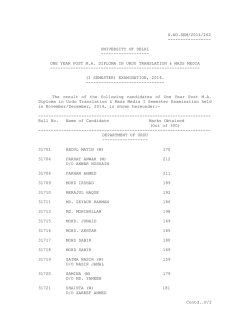
![TIME TABLE MARCH-APRIL 2015 V I III[IMP/BL]](http://s2.esdocs.com/store/data/000483508_1-7e40507e02bf7111da7196362309b7b4-250x500.png)
